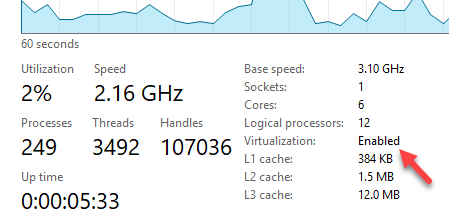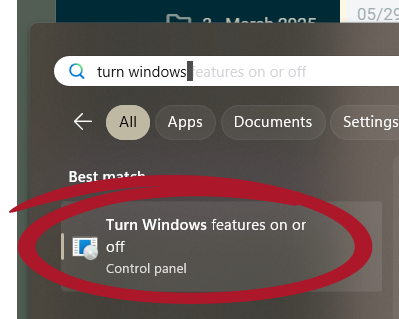
Keeping clients' computers safe and profitable for over 30 years
Home Forms About Current Newsletter subscribe

Windows Sandbox

Preview:
Windows sandbox is a great way to create a fast clean virtual copy of windows as another application on your desktop. This lets you checkout questionable sites, or test software and then close that version of windows and everything just disappears. I'll show you how to set it up and use it.
If you have the Pro version of Windows, which is the only version I sell, then you can turn on Windows Sandbox. Windows sandbox is a separate, sandboxed version of Windows. It runs in a window just like any other application, but it is a full, clean version of Windows. Because it operates in a window like an application, you can copy and paste from your regular version of Windows, or take notes with your normal program while working in the sandboxed Windows. When you close the sandbox, everything inside it is gone. Poof. It opens quickly, much faster than Quickbooks, and anything that happened in the sandbox disappears when closed.
This virtual Windows is shockingly fast, and takes very little space. It is just like running a normal-size Windows app. You can even use ALT-Tab to switch between it and other apps you are using. It uses only about 2 or 3 GB on the disk during usage. It only uses the space needed and doesn't even use that much RAM.
Normal Uses for Windows Sandbox
- Test new software. You can test software and see how it works. Then close the sandbox, and everything is gone.
- Safely open suspicious files or attachments.
- Give a guest the ability to use your computer without giving them any chance to mess with it. They can check their email, visit websites, or play online games. They could even install and use some software. Then, when they close the sandbox, everything is gone. None of their changes remain.
- Troubleshoot some compatibility issues. If a website doesn't work, or there is a problem, you can use a clean windows with no software except just intrinsic Windows to test it.
- Let anyone use the Edge browser to go anywhere on the web without leaving any trace in YOUR windows.
- Experiment with different Windows settings without risking your real system.
- You can learn about Windows settings, PowerShell commands, or other scripts without risking your Windows.
- Allow a child or friend to use your computer for a few days while they visit, without them seeing or affecting your actual Windows installation or settings.
Two Requirements
Windows Pro 10 or 11 (Enterprise and Education also work).
Windows Home does not have this feature. You can check your Windows version by pressing the Windows key and R (for run). Then typing winver and pressing ok or hitting Enter.

Virtualization Enabled in BIOS.
Older computers will probably have virtualization turned off, but it is easy to turn on. Computers sold in the last couple of years with Windows 11 installed could have this feature enabled by default.
You can check whether you have virtualization turned on quickly by pressing CTRL-SHIFT-ESC and running task manager. Then select the performance tab.

If you need to enable virtualization, then things vary by computer, so there isn't a perfect description, but normally, you'll press F2 or DEL when the computer begins to boot to access BIOS. Then choose the Advanced Tab. Then choose something like: CPU Configuration. Then enable either Intel CVMX for Intel chips or SVM for AMD chips.
Enable Sandbox
Windows normally comes with the Sandbox disabled, so you'll need to enable it. Windows comes with hundreds of optional features. Most of them are turned off by default. So, you must access the features list and then turn Windows Sandbox on. You can simply start typing "Turn Windows features and off” from the start button.

Or you can access the list from the control panel.

Then just check the box to enable the setting and restart your computer.

The restart will install everything. It'll take about 10 minutes, so don't be in a rush.
Using Windows Sandbox
You can run this virtual Windows by simply typing Windows Sandbox in the start menu. Once it is running, you can do anything with it. Do your browsing with the Edge Browser. Drag and drop files to or from your regular Windows. You can keep this virtual version of Windows running for days, as you investigate new software or allow a guest to use it for many days.
Download and run files if you like, knowing they will be gone when you choose to close the sandbox. Install whatever you want. When you are done, just close the window, and everything will be gone unless you copied stuff to your own regular version of Windows, for example, to your desktop. Your version of Windows and all your settings will be unaffected.
Advanced Features
It is more than I intend to do with this article, but Microsoft has a simple configuration language with just a few words in it. You can use those commands to make a text file mapping a folder from your Windows into your sandboxed Windows, or automatically installing some program. You can copy and run a portable version of some program you use, like KeePass, LibreOffice, Notepad++, or Joplin. Furthermore, you can specify whether these mapped folders will be read-only or read/write. I'll be happy to help my clients if they want to do this. However, you don't need to do anything to run whatever you want from the web.

This article is licensed under a Creative Commons Attribution-NoDerivs 3.0 Unported License.